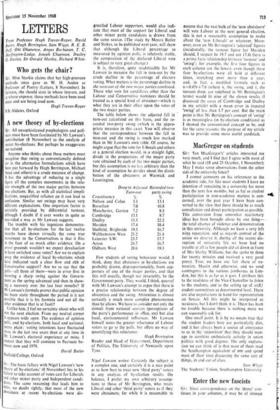Sir: The basic fallacy with Nigel Lawson's 'new theory of
by-elections' (8 November) lies in his failure to take account of votes cast for Liberals and other minor party and Independent candi- dates. The same reasoning that leads him to infer, no doubt rightly, that most of the new abstainers at recent by-elections were dis- gruntled Labour supporters, would also indi- cate that-most of the support for Liberal and other minor party candidates is drawn from the same source. (The study by Messrs Butler and Stokes, to be published next year, will show that although the Liberal percentage as measured by opinion polls, is relatively stable, the composition of the declared Liberal vote is subject to very great change.) It is, therefore, quite inadmissible for Mr Lawson to measure the fall in turn-out by the crude decline in the percentage of electors voting. What matters is the percentage decline in the turn-out of the two major parties combined. Those who vote for candidates other than the Labour and Conservative nominees should be treated as a special kind of abstainer—which is what they are in their effect upon the votes of the two major parties.
The table below shows the adjusted fall in turn-out calculated on this basis, and the re- corded two-party swing (which is the appro- priate measure in this case). You will observe that the correspondence between the fall in turn-out and the swing is much less marked than in Mr Lawson's own table. Of course, he might argue that the vote for Liberals and others at a general election would, in a straight fight, divide in the proportions of the major party vote obtained by each of the two major parties, but this assumption is no less arbitrary than the kind of assumption he derides about the distri- bution of the abstainers at Warwick and Leamington.
Drop in Adjusted Recorded two- Turn-out party swing Constituency
Nelson and Colne 5.1 13.1 Bassetlaw 7.0 10.8 Manchester, Gorton 7.2 9.3 Cambridge 13.1 9.7 Dudley 15.5 22.2 Meriden 17.4 18.4 Sheffield, Brightside 19.5 16.7 Walthamstow West 21.2 21.4 Leicester S.W. 23.7 17.7 Acton 24.7 16.7 Oldham West 28.6 19.3 Few students of voting behaviour would, I think, deny that abstainers in by-elections are probably drawn, disproportionately, from sup- porters of one of the major parties, and that this will usually, though not invariably, be the Government party. They would, I think, quarrel with Mr Lawson's attempt to argue that there is a precise relationship between the degree of abstention and the swing. Abstention is almost certainly a much more complex phenomenon than he allows. We have to consider not only the stimuli from national sources (perceptions of the party's performance in office, etc) but also local, environmental influences. Mr Lawson himself notes the greater reluctance of Labour voters to go to the polls, but offers no way of quantifying this reluctance.
Hugh Berrington Reader and Head of Department, Department of Politics, The University of Newcastle upon Tyne Nigel Lawson writes: Certainly the subject is a complex one, and certainly it is a nice point as to how best to treat new 'third party' voters in any analysis of by-election results. On balance, I prefer my own arbitrary assump- tions to those of Mr Berrington, who treats Liberal and other 'third party' voters as if they were abstainers; for while it is reasonable to
assume that the vast bulk of the 'new abstainers' will vote Labour at the next general election, this is not a reasonable assumption to make about the 'new Liberals' or whatever. More- over, even on Mr Berrington's 'adjusted' figures (incidentally, the turnout figure for Meriden should, I suspect be 19.7 and not 17.4) there is a prima facie relationship between 'turnout' and 'swing': for example, the first four figures in each column are the lowest, even though these four by-elections were all held at different times, stretching over more than a year; and, in fact, a modified formula such as s=0.45-r+7.6 (where s, the swing, and T, the turnout drop, are redefined in Mr Berrington's terms) would fit nine of the eleven results (I discussed the cases of Cambridge and Dudley in my article) with a mean error in imputed 'swing' of less than 1.7 per cent. But the main point is that Mr Berrington's concept of 'swing' is as meaningless (in by-election conditions) as I showed the conventional concept to be, and for the same reasons; the purpose of my article was to provide some more useful yardstick.






































 Previous page
Previous page